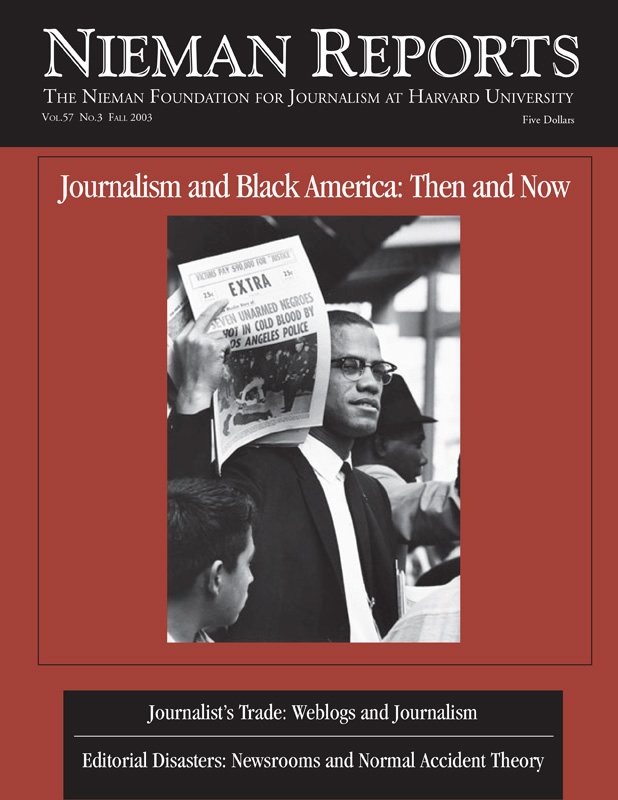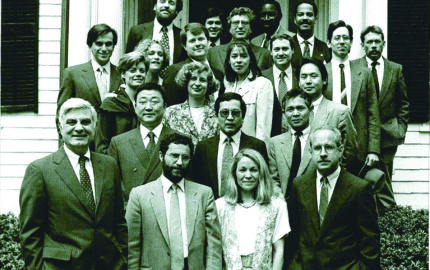This issue of Nieman Reports takes a searching look at reporting on black America and at the racial climate and conversations in U.S. newsrooms. These are topics the magazine has visited before and will likely explore again, since the racial situation both inside and outside the newsroom continues to be a source of tension and unfulfilled aspirations.
Pieces published in the years just following the magazine’s creation in 1947 reported on the American South and the civil rights movement, describing the dangers and difficulties that reporters and photographers faced in chronicling that struggle. Simeon Booker’s account in 1956 of the Emmett Till trial in rural Mississippi told of the uncommon collaboration between 12 black journalists and a few white reporters in investigating the disappearance of witnesses to Till’s murder. Simeon, a reporter for Jet magazine, and the other black newsmen found allies among white reporters in spite of the local sheriff’s order that there was to be no mixing between white and black journalists.
Most reporters covering racial news in the Deep South for mainstream newspapers were white. John Herbers, a chief of United Press International’s Jackson, Mississippi bureau, wrote for Nieman Reports in 1962 about the reality of being despised by the white community and a stranger to the ways of life lived by rural blacks. The framework in which the reporter must function, he said, included harassment by the local newspaper and radio stations “for reporting some behind-the-scenes developments that did not fit the official version of what happened.”
Many years passed before the focus of racial coverage was broadened to address concerns about the inadequacy that resulted when news staffs had few journalists of color and directing editors who were typically white and male. By 1978, U.S. newspapers began to face up to the reality that their workforce did not reflect the racial and ethnic makeup of the communities they served. Journalists of color represented about four percent of the news staff while the percentage of racial and ethnic minorities in the nation’s population was at least three times as large. That year the American Society of Newspapers Editors (ASNE) decided to use its influence to encourage papers to aggressively recruit journalists of color, hoping that newsroom population would reach parity with the national population by 2000.
Robert C. Maynard, an influential leading voice in this effort, wrote in this magazine in 1979 about the consequences of news organizations whose managerial ranks were “purer white than Ivory Snow.” Describing the “unseen environment” of nonwhite America, Maynard wrote, “If anything accounts for the problems of misportrayal, the answer must begin with those statistics” documenting a dominantly white news workforce.
Newspapers have made modest gains since then, but the newsroom population today of slightly more than 12 percent journalists of color badly lags behind the dynamic growth of a nation that is becoming more and more diverse. Committed editors and newspapers—spurred on by newspaper foundations and news industry organizations like ASNE and minority news organizations—have recruited vigorously and can show gains in hiring journalists of color.
Once on the job, however, many journalists of color don’t see promising career prospects and, over time, four of every five leave the newspaper business. It is no secret why retention is the problem. The newspaper industry, by comparison to other industries, invests only modestly in leadership and management training. When spending is tight, training and education, typically, are the first to be cut. By shortchanging their investment in training and education, newspapers are undercutting the value of brainpower and the opportunity to build a culture of lifelong learning that can help sustain a stable, diverse workforce.
In explaining why they turn away from newspaper jobs, journalists of color mention lack of training and opportunity, absence of effective leaders and role models, and uncertainty about the newspaper’s commitment to diversity. Constructive training and educational programs would help journalists of color rise to positions of responsibility in which they could serve as mentors to a new generation of minority journalists. Such a nurturing cycle would inevitably influence greater retention of minorities in newspaper jobs, as well as demonstrate to young journalists of color that newsrooms are a welcoming place for them.
The impact of editors of color on story assignments and judgments about news play would help build credibility and trust among the diverse communities our newspapers are seeking to serve better.
Training, education and commitment to opportunity is the surest course for creating leaders and role models who can show the way to new generations of journalists of color and strengthen the effectiveness of newspapers in an increasingly diverse world. If newspapers fail to make good on their intentions, they will become less credible and more marginal as institutions in their communities.



